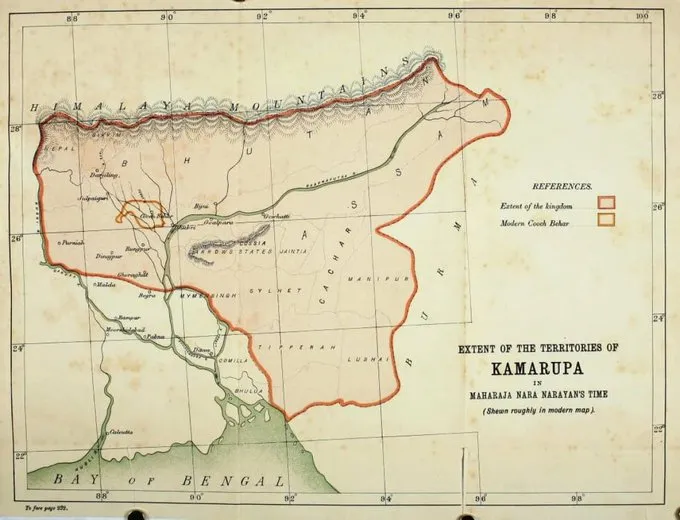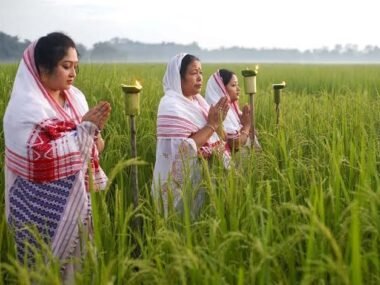Early Life and Family Background
Bir Chilarai: Born in 1510, Shukladhwaj was the younger brother of King Nara Narayana of the Kamata kingdom. He was a prominent general of the Koch royal dynasty of Assam. His exceptional speed in warfare earned him the name “Chilarai,” meaning “Kite Prince.” He was a descendant of the powerful founder of the Koch dynasty, Maharaja Viswa Singha. His father, Viswa Singha, established the Koch kingdom in 1515 AD, marking a significant chapter in Assam’s history. His mother, Padmavati, was from the kingdom of Gaur.
Among the many sons of Viswa Singha, only four were remarkable, and Shukladhwaj, later known as Bir Chilarai, was his third son. Born on a full moon day, he had a fair complexion, which is believed to be the reason behind his name, Shukladhwaj.
Education and Military Training
Shukladhwaj, along with his elder brother Malla Dev, who later became Nara Narayan, received his early education in Assam. For higher education, they traveled to Varanasi, a renowned center of learning. There, they mastered various disciplines, including Sanskrit, grammar, literature, law, and astrology. This extensive education not only enriched their knowledge but also prepared them for administrative and military leadership.
From a young age, Shukladhwaj was trained in warfare, and he excelled in military strategy and combat. His skills on the battlefield and quick strategic thinking made him an exceptional warrior. Under the guidance of his father and elder brother, he mastered the art of warfare, including land and naval battles.
Contribution to the Koch Empire’s Expansion

Bir Chilarai played a crucial role in expanding the empire of his elder brother, Maharaja Nara Narayan. As the commander-in-chief of the Koch army, he led numerous military campaigns that extended the kingdom’s boundaries. His leadership ensured the dominance of the Koch dynasty over several regions.
Victories Over Neighboring Kingdoms
Conquest of the Ahom Kingdom
In June 1563, Bir Chilarai led a massive campaign against the Ahom kingdom. His army crossed the Brahmaputra River and launched an attack on Gargaon, the capital of the Ahoms. With his well-organized strategy and superior combat skills, Chilarai’s forces successfully captured Gargaon. The defeated Ahom king fled, leading to a temporary Koch victory. However, later battles between the Koches and Ahoms resulted in victories for both sides. Eventually, a truce was signed between the two kingdoms.
Defeat of the Kachari Kingdom
Chilarai waged war against the Kachari kingdom (modern-day Dimapur). With his military prowess, he subdued the Kacharis and brought their territory under Koch control.
Campaign Against Manipur and Tripura
Chilarai’s next target was the kingdom of Manipur. Seeing the might of the Koch army, the ruler of Manipur surrendered without resistance. Subsequently, Chilarai attacked the states of Jayantia, Tripura, and Sylhet. He decisively defeated the local rulers, eliminating any opposition.
Submission of Minor Kingdoms
After witnessing Chilarai’s successive victories, the rulers of Khairam and Dimoriya voluntarily submitted their territories to the Koch empire, further expanding its influence.
Patronage to Srimanta Sankardeva
Beyond his military achievements, Chilarai was a patron of art, culture, and religion. He provided protection and shelter to the great Assamese saint and social reformer Srimanta Sankardeva. Recognizing the importance of Sankardeva’s Vaishnavite movement, he extended his support to spread the teachings of Bhakti. He also strengthened his bond with the saint by arranging the marriage of his niece to Sankardeva.
The Battle Against the Afghan Sultanate
In 1568, Nara Narayan and Chilarai launched an ambitious campaign against Gour, which was ruled by the Afghan Sultan Soleman Karnani. However, this time, they faced a formidable opponent in Kalapahar, the general of Soleman Karnani.
Kalapahar led a powerful Afghan force and managed to capture Chilarai during the battle. Following this victory, Kalapahar’s army marched towards Kamakhya, destroying temples along the way. They continued their invasion into parts of the Koch kingdom, temporarily weakening its hold over the region.
Reconstruction and Legacy
Despite the setbacks, Chilarai and Nara Narayan managed to recover their kingdom and rebuild the Kamakhya temple, which had been desecrated during the Afghan invasion. Their efforts ensured the preservation of Assamese heritage and culture.
Chilarai’s legacy continued through his son and grandson, although internal conflicts led to the division of the Koch kingdom. Koch Hajo, a part of the original empire, eventually broke away due to political struggles.
In recognition of his bravery and contributions, Bir Chilarai Divas is celebrated annually in Assam. This day honors his courage, military prowess, and dedication to the Koch empire. It serves as a reminder of his extraordinary achievements and his role in shaping Assam’s history.
Conclusion
Bir Chilarai remains one of the greatest yet lesser-known warriors in Indian history. His contributions to military strategy, empire expansion, and cultural patronage were remarkable. As the commander-in-chief of the Koch army, he played an instrumental role in shaping the political landscape of Assam and Northeast India.
Though time has overshadowed his heroics, his name still resonates in Assamese folklore and history. He was not only a warrior but also a statesman, a patron of the arts, and a true protector of Assamese traditions. The bravery and wisdom of Chilarai continue to inspire generations, cementing his place as an unsung hero of India’s past.
FAQ’s
Q. What is Bir Chilarai Divas?
A: Bir Chilarai Divas is an annual observance in Assam that honors the bravery and contributions of Bir Chilarai, the great military general of the Koch dynasty.
Q. When is Bir Chilarai Divas celebrated?
A: Bir Chilarai Divas is usually celebrated on the full moon day of the Hindu month of Magha (January–February).
Q. Why is he called ‘Chilarai’?
A: The name “Chilarai” means “Kite Prince” because of his exceptional speed and agility in warfare, resembling a kite in swift movement.
Q. What is the significance of Bir Chilarai in Assam’s history?
A: He is regarded as one of the greatest warriors of medieval Assam, known for his swift military campaigns and protection of the Koch kingdom against external threats.












